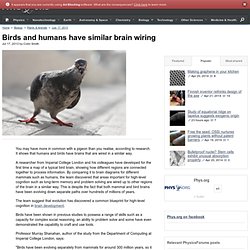

Birds and humans have similar brain wiring. You may have more in common with a pigeon than you realise, according to research.

It shows that humans and birds have brains that are wired in a similar way. A researcher from Imperial College London and his colleagues have developed for the first time a map of a typical bird brain, showing how different regions are connected together to process information. By comparing it to brain diagrams for different mammals such as humans, the team discovered that areas important for high-level cognition such as long-term memory and problem solving are wired up to other regions of the brain in a similar way. This is despite the fact that both mammal and bird brains have been evolving down separate paths over hundreds of millions of years.
The team suggest that evolution has discovered a common blueprint for high-level cognition in brain development. Professor Murray Shanahan, author of the study from the Department of Computing at Imperial College London, says: InnerSuper. Red Gold. Gary Carlson - Illustration & Animation - Medical & Biological. Human-Body-Facts-2-copy.jpg (620×8050) Science & Nature - Human Body and Mind. The Genetic Gamesmanship of a Seven-Sexed Creature. What could be better than two types of sexes?

For one organism, the answer isn’t three, but seven! And to top it off, these seven sexes aren’t evenly distributed in a population, although researchers have now developed a mathematical model that can accurately estimate the probabilities in this crap-shoot game of sexual determination. Meet Tetrahymena thermophila, which in addition to its seven different sexes—conveniently named I, II, III, IV, V, VI, and VII—has such a complex sex life that it requires an extra nucleus. This fuzzy, single-celled critter has a larger macronucleus that takes care of most cellular functions and a smaller micronucleus dedicated to genetic conjugation. The other odd thing about this one-celled wonder is that the population of the seven sexes are skewed, leading Unversity of Houston researcher Rebecca Zufall and her colleagues to ask: What gives? Related Content: 80beats: What Makes a Boy Lizard? Image: Wikimedia Commons / Ayacop.
Virtual Museum of Bacteria. Biology in Motion. Interactive Concepts in Biochemistry - Interactive Animations. XVIVO. Communicating at an unknown rate. Biologija.com.hr - Vijesti - Biologija - Zašto je nekih vrsta na Zemlji mnogo, a nekih malo? Na svijetu postoji više od 400.000 vrsta kornjaša (skupina kukaca), a samo dvije vrste tuatara ili premosnika, rođaka zmija i guštera, koji živi na sjeveru Novog Zelanda.

Zašto evolucija stvara ''pobjednike',' kao što su sisavci i mnoge vrste ptica i riba, a zašto ''gubitnike'' i dalje je jedno od središnjih pitanja evolucijske biologije. Rare and Precious Moments of Animal Life. How interesting can animal life be is something which we can only guess.

By looking these amazing photographs it seems that they have very funny and precious moments. Don Slish Animations. {*style:<b>Animations and Interactive Tutorials Produced by Dr. Donald F. Slish </b>*} This animation shows the molecular mechanisms of the control of cell division by tyrosine kinases and the inhibition of this by p53, when there is slight DNA damage. It also shows the induction of apoptosis when there is severe DNA damage. Other animations: RER protein folding Hypoxic effects on dopamine release Metabotropic Receptor activating an ion channel Ionotropic Receptor Receptor Regulation (Extended) Receptor Regulation (Short form)
Biology in Motion. Gray, Henry. 1918. Anatomy of the Human Body. The Whole Brain Atlas. Brain, Brain Information. Making sense of the brain's mind-boggling complexity isn't easy.

What we do know is that it's the organ that makes us human, giving people the capacity for art, language, moral judgments, and rational thought. It's also responsible for each individual's personality, memories, movements, and how we sense the world. All this comes from a jellylike mass of fat and protein weighing about 3 pounds (1.4 kilograms). It is, nevertheless, one of the body's biggest organs, consisting of some 100 billion nerve cells that not only put together thoughts and highly coordinated physical actions but regulate our unconscious body processes, such as digestion and breathing.
The brain's nerve cells are known as neurons, which make up the organ's so-called "gray matter. " The cerebrum is the largest part of the brain, accounting for 85 percent of the organ's weight. The cerebrum has two halves, or hemispheres. Movement and Balance. Cell Dance 2010, Public Outreach Video Winner. Astonishing Insect Life Photography. Are you looking at me? Scientists discover bizarre flatworm with 60 eyes. Flatworm is completely new speciesDiscovered in grassland near CambridgeBelieved to be of Antipodean descent By Mark Prigg Published: 13:14 GMT, 23 July 2012 | Updated: 08:36 GMT, 24 July 2012 It is one of the oddest creatures ever found.

Scientists today revealed an entirely new species of flatworm. The unique animal has 60 eyes, all crammed into a body just 12mm long. The UK's first 60 eyed flatworm has been discovered on a nature reserve in Cambridge. The creature was found in grassland near Cambridge despite the area being described as the most 'documented place on the planet'.